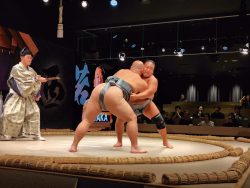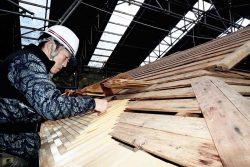
A staff member stands at the counter of the Leach Bar at Rihga Royal Hotel in Kita Ward, Osaka. The interior and furnishings are still the same as they were when the bar first opened.
8:39 JST, April 17, 2021
OSAKA — The Leach Bar at the Rihga Royal Hotel in the Nakanoshima district of Osaka has a gallery-like space where visitors can experience the essence of folk art.
When you step into the bar, you will be struck by unique walls made of glossy rattan arranged diagonally. The thick beams and pillars create a stately atmosphere, and at the same time, you can feel warmth and simplicity.
The floor is covered with Persian carpets, and the items casually lined up here and there are all masterpieces created by great artists like ceramist Kanjiro Kawai and woodblock artist Shiko Munakata.
Even now, more than half a century after its opening, the bar continues to attract many enthusiasts, including regular customers.
Folk craft movement

A ceramic work by Kanjiro Kawai
It was at the end of the Taisho era (1912-1926) that people began to pay attention to “mingei,” folk crafts used in daily life. Philosopher Muneyoshi Yanagi advocated a movement in 1926 to find beauty in such crafts and promote their value widely. He is said to have been struck by the beauty of the handiwork of unknown artisans.
The movement continues even now as the “mingei movement” (folk craft movement).
During the postwar period of rapid economic growth, people became more interested in folk crafts, seeing the loss of traditional techniques and rural landscapes. This interest led to a big boom. At the 1970 Osaka Expo, folk crafts from all over Japan were introduced at a pavilion called “Nippon Mingeikan” (Japan Folk Crafts Museum).

Stained glass windows with natural light
Blending Japanese, Western styles
Rihga Royal’s predecessor hotel opened in 1965, when the folk craft boom was in full swing. The bar was originally built as a “folk craft room.” Tamesaburo Yamamoto, the president at the time, approached Yanagi and others with the idea of creating such a room. Yamamoto was also a supporter of the folk craft movement.
The design was created by Bernard Leach, a British potter who had a deep knowledge of Japan and, along with Yanagi, was the core of the mingei folk craft movement. The bar was named after him. Leach’s original proposals about the interior, such as the rattan walls, were given shape by Isoya Yoshida, a great modern Japanese architect.
The cottage-style restaurant, with a mixture of Japanese and Western styles, still retains much of its original appearance.
“People tend to misunderstand the term ‘mingei’ as something that is simply rustic. The Leach Bar is a place where people can come into contact with the original spirit of mingei,” said Kyoto Kacho University Prof. Tomoo Kawashima, who specializes in the history of modern architecture.
Several of the bar’s regular customers are cultural figures and businesspeople. Conductor Takashi Asahina, who founded the Osaka Philharmonic Orchestra, and writers Ryotaro Shiba and Ken Kaiko are said to have frequented the bar.
Yukio Akamine, 76, a fashion director, is among such cultural figures. He has been visiting the restaurant since its early days.
A resident of Kawasaki, he always stays at the Rihga Royal Hotel on business trips to Osaka. After work, Akamine spends a blissful time at the bar. In his work, he has been pursuing the creation of clothes with high quality materials and tailoring that can be loved for a long time.
“When I come here, it makes me think about what is universally beautiful beyond time,” he said.
Living architecture
The bar has been attracting more attention since it was selected as one of the “Living Architecture Museums” by the city of Osaka. The city government has recognized the bar as a social space with history and prestige that shows the charm of Osaka.
“Some of our guests come from far away for this bar,” said Kei Shinogi, manager of the bar.
The bar has been temporarily closed since last November due to the spread of the novel coronavirus. There are many people who are waiting for it to reopen soon. The bar is scheduled to open when it is deemed safe to do so.
There are many folk art pieces standing in the room, whose interior remains unchanged from the time of its opening. The special space will surely continue to convey the essence of the “beauty of utility” that Yanagi and his colleagues celebrated.

Meriyasu Kaikan building
This retro-looking four-story building stands on the other side of the Dojima River from the Rihga Royal Hotel. It was built in 1929 as the office of an exporter cooperative of the meriyasu fabric that was produced in Osaka.
The building was designed by Hyozo So, an architect who was mainly active in the Kansai area before World War II. The row of windows with arches at the top is impressive to those looking from the outside. After the end of the war, it became a building with leased commercial space, and now houses cafes, restaurants and design offices.
Related Tags
"Features" POPULAR ARTICLE
-

Students Recreate 19th-Century Bento Boxes Made for Ino Tadataka’s Survey Team in Hot Spring Town on Nakasendo Road
-

Santa Claus Delivers Christmas Presents to Penguins at Aquarium in Japan’s Nagasaki Prefecture
-

Sumo Restaurant in Tokyo Teaches Foreign Visitors About the Ancient Sport, with Bouts Between Retired Rikishi
-

Autonomous Passenger Ship Connects Mainland with Remote Island in Seto Inland Sea; World’s 1st Commercially Operated Autonomous Vessel
-

Osaka’s Sumiyoshi Taisha Shrine Bustles with New Year’s Visitors
JN ACCESS RANKING
-

As Chinese Tourists Shun Japan, Hotels and Stores Suffer
-

Osaka-Kansai Expo’s Economic Impact Estimated at ¥3.6 Trillion, Takes Actual Visitor Numbers into Account
-

Japan Govt Adopts Measures to Curb Mega Solar Power Plant Projects Amid Environmental Concerns
-

BOJ Gov. Ueda: Highly Likely Mechanism for Rising Wages, Prices Will Be Maintained
-

Economic Security Panels Debate Supply Chains, Rare Earths; Participants Emphasize Importance of Cooperation Among Allies

























